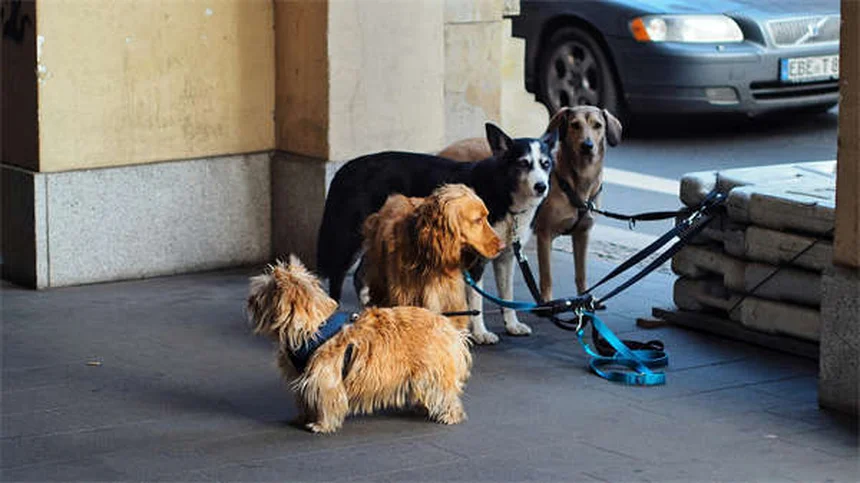Advertisement
Is your senior dog struggling to jump like they used to? The answer is clear: dog ramps can be a game-changer for aging pets. Just like my Boston Terrier Harley, who went from bed-jumping champion to needing assistance in her golden years, many older dogs benefit from ramps. Veterinarians agree that ramps help prevent injuries in dogs with arthritis, joint issues, or mobility challenges. Whether it's getting into the car or climbing onto the couch, a good ramp reduces strain on your pup's body. We'll walk you through everything you need to know - from choosing the right ramp to training your dog to use it safely. Trust me, your furry friend will thank you for making their life easier!
E.g. :Fear Aggression in Dogs: 7 Signs & How to Stop It Safely
- 1、Is Your Senior Dog Struggling to Jump Like Before?
- 2、Ramps vs. Stairs: Which Solution is Right for You?
- 3、What Features Should You Look For?
- 4、Special Situations to Consider
- 5、Final Tips Before You Buy
- 6、The Emotional Benefits of Dog Ramps You Never Considered
- 7、Creative Ways to Incorporate Ramps Into Your Home
- 8、Common Mistakes to Avoid When Using Ramps
- 9、When to Upgrade Your Dog's Ramp
- 10、Beyond Ramps: Complementary Solutions
- 11、FAQs
Is Your Senior Dog Struggling to Jump Like Before?
Let me tell you about Harley, my Boston Terrier. As a puppy, she could leap from the floor to our bed like a furry little superhero. But after ten years? Let's just say her jumping days were over. That's when we realized she needed a dog ramp - and your aging pup might too!
Signs Your Dog Needs Assistance
Does your dog hesitate before jumping? Maybe they pant or whine after landing? These are clear signals that jumping is becoming painful. Continuing to jump can lead to serious injuries, especially for older dogs or those with joint issues.
I've seen too many cases where stubborn pet owners think "he'll be fine" - until their dog hurts themselves. Don't wait for that to happen! If your dog shows any discomfort with jumping, it's time to consider alternatives. Remember, prevention is always better than treatment.
Which Dogs Benefit Most?
Not just senior dogs need ramps! Here's a quick comparison of dogs that should use ramps:
| Dog Type | Reason for Needing Ramp |
|---|---|
| Large breeds | Prevent joint stress |
| Dogs with arthritis | Reduce pain |
| Disabled dogs | Maintain mobility |
| Post-surgery dogs | Avoid re-injury |
Did you know Great Danes are especially prone to joint problems? That's why I always recommend ramps for giant breeds. Even if your dog seems fine now, starting them on a ramp early can prevent future issues.
Ramps vs. Stairs: Which Solution is Right for You?
 Photos provided by pixabay
Photos provided by pixabay
Space and Budget Considerations
Let's be real - not everyone has space for a giant ramp in their living room! That's where stairs come in handy. They're compact, affordable, and perfect for helping small dogs reach the couch.
But here's the thing: stairs aren't ideal for every situation. If you've got a large dog or need something for car access, ramps are usually better. Sure, they take up more space, but they're gentler on joints and easier for big pups to navigate.
Making the Right Choice
Ever tried lifting a heavy ramp into your car? Not fun! That's why weight matters when choosing a ramp. You want something sturdy enough for your dog but light enough for you to handle.
Here's a pro tip: look for ramps with non-slip surfaces. I've seen too many dogs get nervous on slippery ramps. Horizontal slats or rubberized surfaces give them the confidence to climb safely. And make sure the ramp locks in place - nobody wants a collapsing ramp mid-use!
What Features Should You Look For?
Safety First
Can your dog see the ramp at night? You'd be surprised how many people forget this! Older dogs often have poor night vision, so consider adding reflective strips or placing the ramp in a well-lit area.
Think about stability too. A wobbly ramp is worse than no ramp at all. Look for models with non-skid feet and secure locking mechanisms. Your dog's safety is worth the extra few dollars for quality construction.
 Photos provided by pixabay
Photos provided by pixabay
Space and Budget Considerations
How often will you use the ramp? If it's just for occasional car trips, a foldable model makes sense. But for daily bed access, you'll want something more permanent.
Here's a question many owners don't ask: "Can my dog actually use this independently?" Some dogs need training to feel comfortable with ramps. Be patient and use treats to encourage them - it's worth the effort!
The answer is simple: start slow. Place treats along the ramp's length and praise every small success. Most dogs learn quickly when they associate the ramp with positive experiences.
Special Situations to Consider
For Dogs with Special Needs
Dogs recovering from surgery or with mobility issues need extra consideration. Their ramps should have gentle slopes (18-20 degrees is ideal) and plenty of traction.
I remember one client whose Dachshund kept reinjuring his back. Once they got a properly angled ramp, the difference was amazing! The dog could move freely without pain, and the owners stopped worrying about constant vet visits.
Traveling with Your Dog
Do you take your dog on road trips? Then you'll appreciate portable ramps! Many models fold up small enough to fit in your trunk, yet unfold to provide safe vehicle access.
Here's another important question: "What if my dog gets injured while we're away from home?" Having a travel ramp means you're always prepared for emergencies. It's one of those things you don't need until you really need it!
The solution is simple: invest in a lightweight, portable ramp before you need it. That way, you're prepared for any situation that might arise during your travels.
Final Tips Before You Buy
 Photos provided by pixabay
Photos provided by pixabay
Space and Budget Considerations
If possible, let your dog try the ramp before buying. Some pet stores have demo models, or you might find a friend who owns one. Every dog has different preferences, so testing helps ensure a good fit.
Watch how your dog reacts. Do they walk confidently, or do they hesitate? The right ramp should make them feel secure, not anxious. And don't forget to check the weight capacity - it should comfortably support your dog's size.
Maintenance Matters
Like any pet product, ramps need occasional care. Wipe down surfaces regularly, check for wear and tear, and replace any damaged parts immediately.
I've seen ramps last for years with proper care. It's a small investment that pays off in your dog's comfort and safety. Your furry friend deserves the best, and a good ramp delivers exactly that!
The Emotional Benefits of Dog Ramps You Never Considered
Reducing Anxiety for Both of You
You know that guilty feeling when your dog stares at you, wanting to join you on the couch but can't jump up anymore? That's emotional distress neither of you needs! A ramp eliminates this daily frustration and keeps your bond strong.
I've witnessed countless "lightbulb moments" when owners realize how much happier their dogs become with ramps. The confidence boost is incredible - suddenly your senior pup can access favorite spots independently again. No more waiting for you to lift them, no more feeling left out during family time. It's about dignity as much as mobility!
Preventing Future Behavioral Issues
Did you know mobility limitations can lead to behavioral problems? Frustrated dogs might start chewing furniture or develop separation anxiety. A simple ramp could prevent these issues entirely by maintaining their normal routines.
Take my neighbor's Labrador, Max. When he stopped being able to jump into the car, he began whining excessively and pacing. After getting a ramp? Complete transformation! The familiar routine restored his calm demeanor. Sometimes the solution to behavioral issues is simpler than we think.
Creative Ways to Incorporate Ramps Into Your Home
Multi-Purpose Ramp Designs
Why settle for boring when you can have functional AND stylish? Modern pet ramps double as storage benches, side tables, or even bookshelves. I recently saw one with built-in toy storage that solved two problems at once!
Here's a comparison of popular multi-functional ramp designs:
| Design Type | Bonus Features | Best For |
|---|---|---|
| Storage Ottoman | Hidden compartment, seating | Small spaces |
| Bookshelf Ramp | Display shelves, sturdy base | Home offices |
| Pet Staircase | Drawers underneath | Bedroom access |
These innovative designs prove pet accessories don't have to clash with your decor. You can keep your home looking great while accommodating your dog's needs - it's the ultimate win-win!
DIY Ramp Solutions
Are you handy with tools? Building a custom ramp lets you perfectly match your home's measurements and style. Use leftover hardwood flooring for a sleek look, or repurpose an old wooden ladder as the base structure.
My favorite DIY tip: add carpet remnants for traction. Not only does this provide grip, but it also muffles the sound of paws climbing - perfect for light sleepers! Just ensure the slope isn't too steep and include side rails for safety.
Common Mistakes to Avoid When Using Ramps
Improper Placement Pitfalls
Ever seen a ramp placed directly on slippery hardwood? Recipe for disaster! Always position ramps on stable, non-slip surfaces. Use rubber mats underneath if necessary.
Another frequent mistake? Choosing locations with distractions. Placing a ramp near a window where squirrels run by might make your dog too excited to use it safely. Find quiet, familiar spots for best results.
Training Errors That Backfire
Rushing the training process is the #1 reason some dogs reject ramps. Would you feel comfortable walking a tightrope without practice? That's how steep ramps feel to hesitant dogs!
Start with the ramp completely flat on the ground. Let your dog walk across it like a bridge. Gradually increase the angle over several days. Patience is key - forcing the issue creates negative associations that take longer to overcome.
When to Upgrade Your Dog's Ramp
Signs It's Time for a Change
Does your dog hesitate more than usual? Maybe the surface has worn smooth, or the ramp creaks suspiciously. These are clear indicators you need an upgrade.
I recommend inspecting ramps every six months. Check for loose joints, frayed carpet, or bent supports. A well-maintained ramp should last years, but nothing lasts forever - especially with enthusiastic pups using it daily!
Adapting to Changing Needs
As dogs age, their requirements evolve. What worked at 10 might not suffice at 12. Maybe you need a gentler slope, wider platform, or additional handrails for your own stability when assisting them.
Remember Mrs. Johnson's Golden Retriever? The ramp that served him well for years suddenly became inadequate after his vision worsened. Adding textured tape along the edges made all the difference. Regular reassessment ensures the ramp grows with your dog.
Beyond Ramps: Complementary Solutions
Joint Supplements That Help
While ramps assist with mobility, supplements like glucosamine can improve joint health from within. Many veterinarians recommend combining physical aids with nutritional support for best results.
But here's the catch - not all supplements are equal. Look for veterinary-recommended brands with proven ingredients. The cheap stuff at discount stores often contains fillers without therapeutic benefits.
Physical Therapy Techniques
Simple massage and stretching routines can dramatically improve your dog's flexibility. Gentle leg extensions before using the ramp help warm up stiff joints.
Ever tried hydrotherapy? The buoyancy of water allows dogs to exercise without joint stress. Many rehabilitation centers offer sessions, or you can create a shallow paddling area at home. Combined with ramp use, these therapies keep senior dogs active and happy!
E.g. :The 13 Best Dog Ramps for Senior, Arthritic, and Recovering Pups
FAQs
Q: How do I know if my dog needs a ramp?
A: Watch for these telltale signs: hesitation before jumping, panting after landing, or whining when moving. If your senior dog used to leap onto furniture effortlessly but now struggles, it's time to consider a ramp. We recommend ramps for all dogs over 7 years old, large breeds prone to joint issues, and any dog recovering from surgery. Remember, it's better to start using a ramp too early than too late - preventing injuries is much easier than treating them!
Q: What's better for small dogs - ramps or stairs?
A: For small dogs, stairs are often the more practical choice. They take up less space in your living room and are generally more affordable. However, if your small dog has back problems (common in Dachshunds and Corgis), a ramp with a gentle slope is safer. We've found that most small dogs adapt quickly to stairs, especially if you place their favorite blanket or treats on each step during training. The key is choosing a stable, well-constructed product regardless of which option you select.
Q: How steep should a dog ramp be?
A: The ideal incline for dog ramps is 18-20 degrees. This gentle slope makes it easy for arthritic or weak dogs to climb without straining their joints. We've tested dozens of ramps and found that anything steeper than 25 degrees becomes challenging for most senior dogs. If you're using the ramp for car access, measure your vehicle's height first - some SUVs require longer ramps to maintain the proper angle. Pro tip: Look for ramps with adjustable lengths to accommodate different situations!
Q: Can I train my dog to use a ramp if they're scared?
A: Absolutely! Positive reinforcement works wonders for ramp training. Start by placing treats along the ramp's length and praising any interaction. Many dogs learn quickly when you break the process into small steps: first approaching the ramp, then putting paws on it, and finally walking the full length. We recommend short, daily training sessions with high-value rewards. If your dog remains nervous after a week, try a different ramp surface - some dogs prefer carpeted ramps while others do better with rubberized textures.
Q: What features are most important in a quality dog ramp?
A: Three features are non-negotiable: non-slip surface, sturdy construction, and proper weight capacity. Look for ramps with rubberized treads or horizontal slats for traction. The frame should be solid enough not to wobble when your dog uses it. We always check the weight limit - it should be at least 25% more than your dog's current weight. Bonus features we love: foldable designs for easy storage, carrying handles for portability, and weather-resistant materials for outdoor use. Remember, a good ramp is an investment in your dog's long-term comfort!












